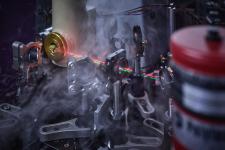Physicists develop new method to visualise magnetic nanostructures with high resolution

Normal optical microscopes are limited by the wavelength of light and details below around 500 nanometres cannot be resolved. The new method overcomes this limit by utilising the anomalous Nernst effect (ANE) and a metallic nano-scale tip. ANE generates an electrical voltage in a magnetic metal that is perpendicular to the magnetisation and a temperature gradient. "A laser beam focuses on the tip of a force microscope and thus causes a temperature gradient on the surface of the sample that is spatially limited to the nanoscale," says Professor Georg Woltersdorf from the Institute of Physics at MLU. "The metallic tip acts like an antenna and focusses the electromagnetic field in a tiny area below its apex." This enables ANE measurements with a much better resolution than conventional light microscopy allows. The microscopic images published by the research team achieve a resolution of around 70 nanometres.
Previous studies have only investigated magnetic polarization in the sample plane. However, according to the research team, the in-plane temperature gradient is also crucial and allows to probe the out-of-plane polarization using ANE measurements. In order to close this gap and demonstrate the reliability of the ANE method for visualising magnetic structures on the nanometre scale, the researchers used a magnetic vortex structure.
A particular advantage of the new technique is that it also works with chiral antiferromagnetic materials. "Our findings are significant for the thermoelectric imaging of spintronic components. We have already demonstrated this with chiral antiferromagnets," says Woltersdorf. "With our method has two advantages: on the one hand, we have greatly improved the spatial resolution of magnetic structures, far beyond the possibilities of optical methods. Secondly, it can also be applied to chiral antiferromagnetic systems, which will directly benefit our planned Cluster of Excellence 'Centre for Chiral Electronics’," says Woltersdorf. Together with Freie Universität Berlin, the University of Regensburg and the Max Planck Institute of Microstructure Physics in Halle, MLU is applying for funding as part of the Excellence Strategy. The aim of the research is to lay the foundations for new concepts for the electronics of the future.
The work was funded by the German Research Foundation (DFG) as part of the Collaborative Research Centre / Transregio (CRC TRR) 227, Project-1D 328545488.
Study: Pandey A. et al. Anomalous Nernst effect based near field imaging of magnetic nanostructures. ACS nano (2024). doi: 10.1021/acsnano.4c09749

